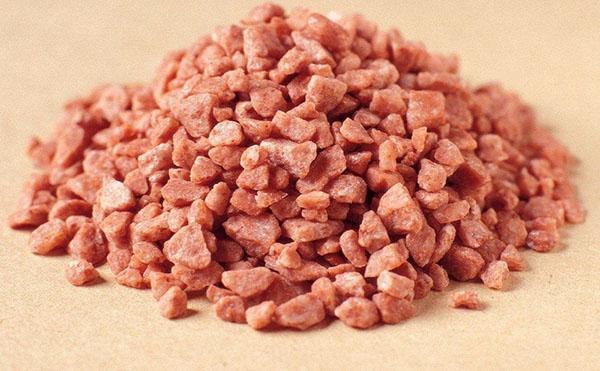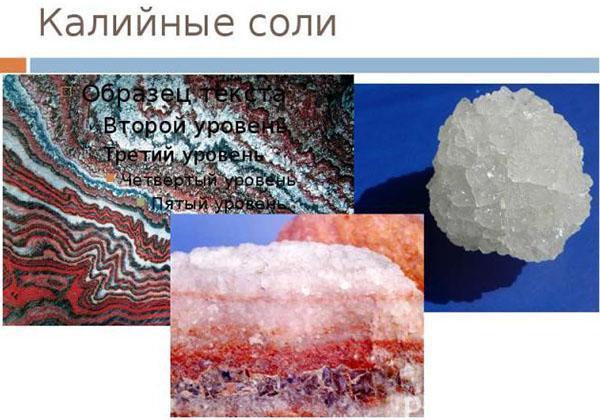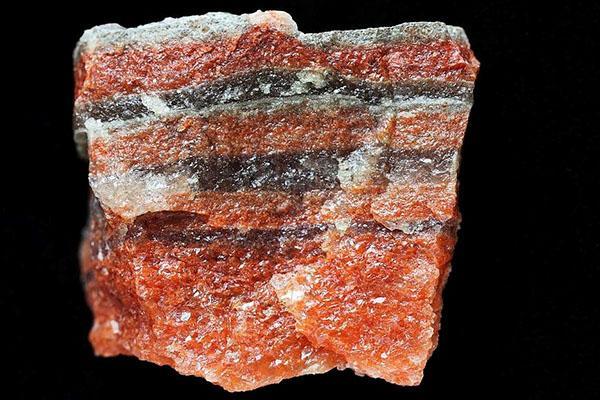To get a good harvest you need potassium salt fertilizer
 Without adequate nutrition, both humans and plants die over time. A universal fertilizer - potash salt - will help fill the gap in one of the most important elements in the world of flora. Potassium has a wide range of effects. Its chemical compounds help to increase the resistance of crops to diseases. They also make plants more resistant to abnormal natural phenomena: droughts and severe frosts.
Without adequate nutrition, both humans and plants die over time. A universal fertilizer - potash salt - will help fill the gap in one of the most important elements in the world of flora. Potassium has a wide range of effects. Its chemical compounds help to increase the resistance of crops to diseases. They also make plants more resistant to abnormal natural phenomena: droughts and severe frosts.
Yet the main function of this macroelement is to stabilize the work of the reproductive organs of plants. Potassium salt has a beneficial effect on seed germination, accelerates the formation of primordia, and also contributes to the normal development of grains.
Potash salt is essential for many crops, but not in equal quantities. For example, potatoes, beets, cucumbers and fruit trees need such feeding much more than tomatoes or cereals.
Fertilizer potash salt: in search of a "gold mine"

 The valuable mineral is extracted in special mines. However, due to the fragile structure and instability of the rock, this work is considered to be very dangerous.
The valuable mineral is extracted in special mines. However, due to the fragile structure and instability of the rock, this work is considered to be very dangerous.
The most famous deposits of potash salt in the world are:
- Gremyachinskoe and Bereznyanskoe (Perm Territory) in Russia.
- Kalush-Golinskoe (Ivano-Frankivsk), as well as Stebnikovskoe (Lviv region) in Ukraine.
- Soligorskoe and Starobinskoe (Minsk region) in Belarus.
- Sakchevan Basin in Canada.
 Among other things, there are industrial enterprises in Germany, Israel, the USA, China and Jordan for its extraction. This natural crystal is used in various fields: in the production of paints, leather, pyrotechnic products, and glass. The mineral also plays an important role in medicine.
Among other things, there are industrial enterprises in Germany, Israel, the USA, China and Jordan for its extraction. This natural crystal is used in various fields: in the production of paints, leather, pyrotechnic products, and glass. The mineral also plays an important role in medicine.
Potassium impurities (up to 3%) are found in heavy types of soils, since they are best retained in such a structure. In light substrates, the amount of macronutrient is only 0.05%. But in peat bogs it is practically absent.
A collection of fertilizers derived from potash salt
 Pure potassium is a poorly soluble chemical element that accumulates only in the upper layers of the soil. Since it is poorly soluble in water, it is difficult for plants to assimilate it. This problem can be solved thanks to the correct structure of complex fertilizers. They are designed so that crops can easily absorb these compounds.
Pure potassium is a poorly soluble chemical element that accumulates only in the upper layers of the soil. Since it is poorly soluble in water, it is difficult for plants to assimilate it. This problem can be solved thanks to the correct structure of complex fertilizers. They are designed so that crops can easily absorb these compounds.
Thus, on the basis of the extracted natural mineral, 5 different types of potash fertilizers are produced:
- Potassium sulfate. The absence of harmful impurities of chlorine, sodium and magnesium in its composition makes the agrochemical the most optimal preparation for feeding fruit and berry crops.

- Fertilizer potash salt in its pure form. Top dressing is applied only for autumn digging with a calculation of 30-40 g / m².

- Kalimagnesia. Serves as an excellent nutritional supplement for potatoes, clover and flax. Indeed, in addition to potassium (26%), it also contains magnesium (8-16%), which is important for crops that do not tolerate chlorine compounds.

- Potassium nitrate (38%).It feeds seedlings or greenhouse specimens, thereby accelerating the process of ripening their fruits.

- Potassium chloride. The fertilizer contains up to 50-60% chlorine and the main component. Such a concentrate is detrimental to fruit and berry plants, therefore it is recommended to apply it only in winter. In a few months, the meltwater will wash out harmful substances, and they will go into deeper layers of the soil.

In fact, the potassium salt is a mixture of potassium chloride, sylvinite fine fractions, and kainite. It is worth knowing that 40% agrochemical is contraindicated in berry crops.
Do not forget about wood ash, which includes the whole complex of macronutrients: potassium (up to 10%), calcium, phosphorus and magnesium. It is the most readily available resource for farmers. It is applied throughout the year, regardless of the growing season of the plants. It has the most fruitful effect on root crops, as well as currants and cabbage.
The main properties of potassium salt and features of its use
 Some people practice adding potassium salt in the spring. But this is done only if the soil in the garden is very wet. Then there is a possibility that heavy chloride compounds will be washed out from the soil. Taking into account the properties of potassium salt and the peculiarities of its use, we can conclude that fertilization is not worth it in the summer.
Some people practice adding potassium salt in the spring. But this is done only if the soil in the garden is very wet. Then there is a possibility that heavy chloride compounds will be washed out from the soil. Taking into account the properties of potassium salt and the peculiarities of its use, we can conclude that fertilization is not worth it in the summer.
To understand when it is best to use it, you need to consider the signs of potassium deficiency in plants:
- the stems acquire a pale shade and begin to wriggle;
- rusty spots appear on the foliage;
- the fruits of the crop become smaller, the yield drops sharply;
- the growth of the culture slows down, since the root system is depleted;
- the tips of the leaves begin to die off;
- the plant is constantly sick.
In some cases (snowy winter, wet ground), the garden is fertilized in early spring. This is done either by the point method, or everywhere. The dosage of the drug is 25-30 g / 10 m².
 When such “symptoms” appear, drastic measures are needed. Given the basic properties of potassium salt, the gardener should correctly calculate the dosage of dressings. In the form of crystals, the substance is carried throughout the entire territory of the garden, and then dug up together with the ground. For every 1 m² of land, you will need up to 15-20 g of the mixture. In addition, it is not recommended to mix the chemical with dolomite flour, lime or chalk.
When such “symptoms” appear, drastic measures are needed. Given the basic properties of potassium salt, the gardener should correctly calculate the dosage of dressings. In the form of crystals, the substance is carried throughout the entire territory of the garden, and then dug up together with the ground. For every 1 m² of land, you will need up to 15-20 g of the mixture. In addition, it is not recommended to mix the chemical with dolomite flour, lime or chalk.
Among gardeners, potassium sulfate is especially popular. It is advised to use it when planting fruit plants: 150-200 g is added to each planting hole. In addition, fertilizer can be applied in spring under strawberries (15-20 g / m²), potatoes, cabbage, beets and carrots (up to 30 g / m²).
 From the above, it follows that if a gardener wants to get a decent harvest, he needs to use potash salt - a fertilizer that is worth its weight in gold. However, it is better to plan the event in the fall (before digging). In exceptional cases, it is carried out in early spring, introducing crystals into moist soil.
From the above, it follows that if a gardener wants to get a decent harvest, he needs to use potash salt - a fertilizer that is worth its weight in gold. However, it is better to plan the event in the fall (before digging). In exceptional cases, it is carried out in early spring, introducing crystals into moist soil.